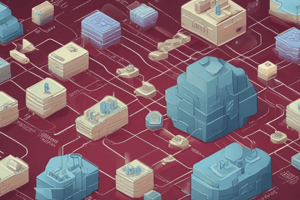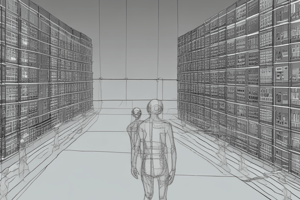Podcast
Questions and Answers
A network device learns MAC addresses to direct data traffic at the data link layer. What type of device performs this function?
A network device learns MAC addresses to direct data traffic at the data link layer. What type of device performs this function?
- Switch (correct)
- Firewall
- Hub
- Router
The Transport layer is responsible for dividing sending data and reassembling it at the destination. What are these divided units of data called?
The Transport layer is responsible for dividing sending data and reassembling it at the destination. What are these divided units of data called?
- Frames
- Datagrams
- Packets
- Segments (correct)
IPv6 addresses are significantly larger than IPv4 addresses. How many bits are in an IPv6 address?
IPv6 addresses are significantly larger than IPv4 addresses. How many bits are in an IPv6 address?
- 128-bit (correct)
- 256-bit
- 64-bit
- 32-bit
Which of the following network security components enforces network security policies by filtering traffic?
Which of the following network security components enforces network security policies by filtering traffic?
In the TCP/IP model, data transmission can occur in different modes. Which mode allows data to be sent in both directions, but only one direction at a time?
In the TCP/IP model, data transmission can occur in different modes. Which mode allows data to be sent in both directions, but only one direction at a time?
Flashcards
What is a switch?
What is a switch?
A network device that learns MAC addresses to efficiently direct data traffic within a network.
What does the Transport Layer do?
What does the Transport Layer do?
Divides data into segments for transmission and reassembles them at the destination.
What is IPv6?
What is IPv6?
A 128-bit IP address, offering a significantly larger address space than IPv4.
What is a Firewall?
What is a Firewall?
Signup and view all the flashcards
What is ARP?
What is ARP?
Signup and view all the flashcards
Study Notes
- A Switch is a data link layer network device that learns MAC addresses of computers in order to transmit data traffic.
- The Transport layer divides sending data into segments and reassembles the received data.
- IPv6 is a 128-bit IP address.
- A firewall is software (and hardware) that enforces network security policies.
- The TCP/IP model has 4 layers.
- Arp resolves IP addresses to Media Access Control (MAC) addresses.
- FTP is a protocol commonly used to download/upload files over the internet or an internal network.
- The logical port number 22 is used by SSH for data transmission.
- The mode of data transmission that can send data both ways but only one way at a time is called Half-duplex.
- Switches operate at the Data link layer of the OSI Model.
- If the MAC address of a network device is 48-EB-62-29-E5-7E, then the network device vendor name is Murata Manufacturing Co, Ltd
- Kerberos is the default authentication protocol used by clients wanting access to Microsoft Active Directory domain and uses port 88.
Studying That Suits You
Use AI to generate personalized quizzes and flashcards to suit your learning preferences.




